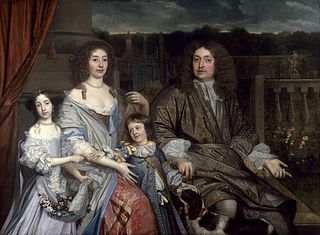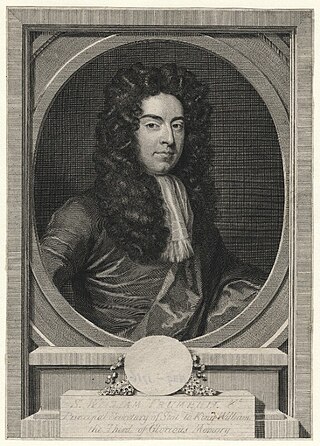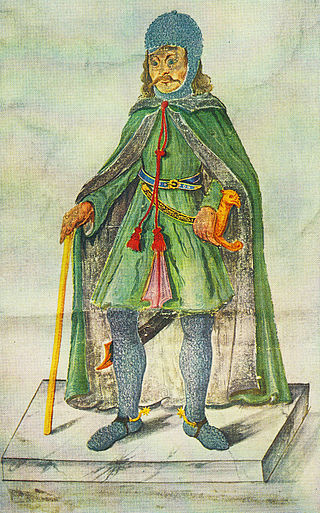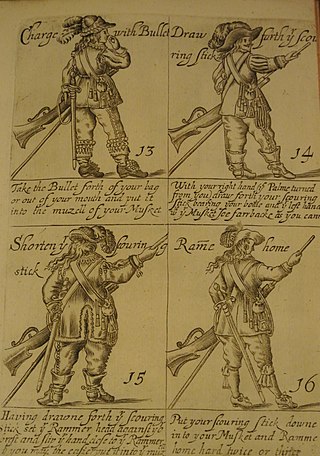The Treasurer of the Household is a member of the Royal Household of the Sovereign of the United Kingdom. The position is usually held by one of the government deputy Chief Whips in the House of Commons. The current holder of the office is Mark Tami MP.

Sir Robert Vyner, 1st Baronet was an English banker, goldsmith and Lord Mayor of London.

George Legge, 1st Baron Dartmouth PC was a Royal Navy officer and politician who was appointed Admiral of the Fleet by James II of England in September 1688. However, he failed to intercept a Dutch invasion force under William of Orange that landed at Torbay on 5 November 1688 and was dismissed following the Glorious Revolution.

Sir William Trumbull, PC was an English diplomat and politician who was a member of the First Whig Junto.

HMS Monmouth was an Intrepid-class 64-gun third rate ship of the line of the Royal Navy, built by Israel Pownoll and launched on 18 April 1772 at Plymouth. Being relatively compact in relation to her gun power, she was affectionately known as the "Little Black Ship".

Sir Anthony Deane, FRS was an English shipwright and politician who sat in the English House of Commons and served as mayor of Harwich.

HMS St Andrew was a 96-gun first-rate ship of the line of the Royal Navy, built by Christopher Pett at Woolwich Dockyard under the supervision of Christopher Pett until his death in March 1668, completed by Jonas Shish, and launched in 1670. Commanded by George Churchill, she took part in the 1692 victory over the French navy at Barfleur & La Hogue.
HMS Unicorn was a 46-gun second rate ship of the line of the English Royal Navy, launched at Woolwich in 1634.

The Lieutenant of the Tower of London serves directly under the Constable of the Tower. The office has been appointed at least since the 13th century. There were formerly many privileges, immunities and perquisites attached to the office. Like the Constable, the Lieutenant was usually appointed by letters patent, either for life or during the King's pleasure.
English county histories, in other words historical and topographical works concerned with individual ancient counties of England, were produced by antiquarians from the late 16th century onwards. The content was variable: most focused on recording the ownership of estates and the descent of lordships of manors, thus the genealogies of county families, heraldry and other antiquarian material. In the introduction to one typical early work of this style, The Antiquities of Warwickshire published in 1656, the author William Dugdale writes:
I offer unto you my noble countriemen, as the most proper persons to whom it can be presented wherein you will see very much of your worthy ancestors, to whose memory I have erected it as a monumentall pillar and to shew in what honour they lived in those flourishing ages past. In this kind, or not much different, have divers persons in forrein parts very learnedly written; some whereof I have noted in my preface: and I could wish that there were more that would adventure in the like manner for the rest of the counties of this nation, considering how acceptable those are, which others have already performed

Vice-Admiral Sir William Berkeley was a Royal Navy officer who saw service during the Second Anglo-Dutch War, rising to the rank of vice-admiral.

Sir William Le Neve (1600?–1661) was an English herald and genealogist.

Twickenham Park was an estate in Twickenham in south-west London.

Thomas Jenner was an English author, engraver, and publisher in London. He kept from 1624 a print-shop by the south entrance of the Royal Exchange; it was recommended by John Evelyn to Samuel Pepys.
Sir Elisha Leighton was a Scottish courtier and government official.
Sir Robert Coke of Caludon Castle, Coventry, Huntingfield, Suffolk, and Epsom, Surrey, was an English politician.

Nicholas Oudart was a Flemish career official and courtier, who acted as secretary to Charles I and Charles II of England, and to William of Orange in the Netherlands.












